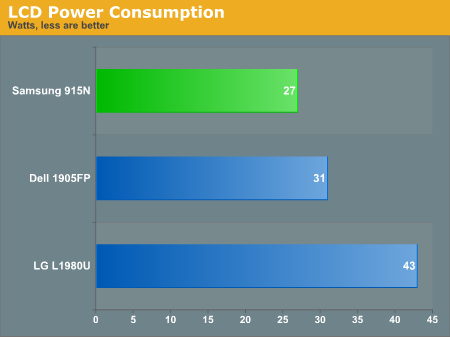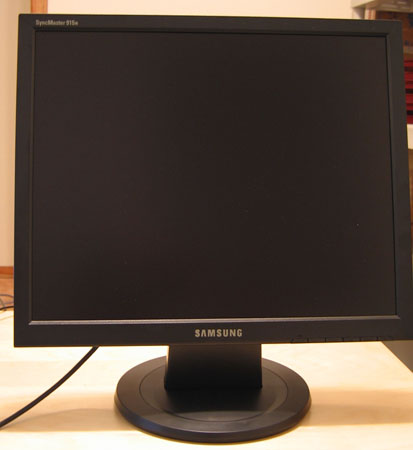Samsung SyncMaster 915N: 8ms Response Times
by Kristopher Kubicki on May 25, 2005 12:05 AM EST- Posted in
- Displays
Construction
As far as Samsung displays go, this is perhaps one of the least aesthetically pleasing displays that we have seen (next to the 910V). Plain looks aren’t a bad thing, but the utilitarian black bezel, stand and control panel are certainlydifferent than most Samsung displays that we get to take a look at. Samsung’s low end displays, like the “N” and “V” series, don’t have much to boast for looks. The display does not rotate along any axis, but does tilt slightly. The display does not offer any screen pivoting features, like its near competitor the Hyundai ImageQuest L90D+.| Samsung SyncMaster 915N | |
| Advertised LCD | 19" SXGA LCD (Active Matrix) pixel pitch: 0.294mm Anti-glare coating "B-TN II" 6-bit LCD Panel |
| Advertised Scanning Frequency | Horizontal: 31-80kHz Vertical: 56-75Hz |
| Advertised Response Time | 8ms (TrTf) |
| Advertised Viewing Angle | 160 / 160 (Horizontal / Vertical) |
| Advertised Contrast Ratio | 700:1 (Typical) |
| Advertised Compatibility | 1280 x 1024 (Native) |
| Advertised Brightness | 300 cd/m2 |
| Advertised Warranty | 3 years parts and labor |
The “B-TN II” LCD panel is really nothing more than a glorified TN display. Samsung has already produced a panel based on this technology, the SyncMaster 172X. Unfortunately, this display was fairly pricy and had some difficulty competing with other displays in the same category. Needless to say, the 915N is virtually the same thing as the 172X on the inside, with some small differences to DSP and pixel pitch. The MagicSpeed technology advertised to lower response time isn’t really anything spectacular; it is just the marketing name for low response time. As for the 8ms advertised response time, the 8ms actually only seems to refer to the Tr portion of the transient phase. The 915N is no different than the SyncMaster 172X as far as response time goes.
The SyncMaster 915N is a little different than other displays that we have seen as “some assembly” is required. This really entails just screwing the base of the monitor into the stand, but it would be very easy to assemble this display and not screw the base in (which would result in the monitor crashing down after a few minutes of use). The display also includes mounts for a VESA arm.













43 Comments
View All Comments
Spacecomber - Sunday, May 29, 2005 - link
LX, the only non-TN (ie, a 8-bit) panel that I am aware of that is suitable for gaming is the 20" IPS panel from LG Philips, which is found in the Dell 2001FP, for example. This is specified as a 16ms panel (as you noted, for whatever that is worth). It probably is not as blur-free as the fastest TN monitors, but I think many would consider this monitor "good-enough" for gaming. I would guess-timate that it is similar to a 12ms TN panel in this regard, since IPS panels do not show quite the same increase in response times when comparing black to white transitions to more subtle black to grey or grey to grey transitions as the TN panels do (and even more so VA panels, which really suffer in this area).This panel is used in LCDs from other manufacturers, as well. BenQ's FP2091, for example, which is not a big surprise sine BenQ appears to be the OEM behind the Dell 2001FP.
You can pick out some other likely candidates from this list, http://www.tftpanel.hu/index.php?topic=monitortabl... . The site is non-english, but the tables are still quite readable.
There may be other 8 bit panels that can keep up with the LG Philips LM201U04, but I'm not aware of them at this time. Well, except maybe for the wide screen version of this panel. See Anandtech's comparison of the Dell and Apple versions of these 20" widescreens to see what they thought of them.
Space
jiulemoigt - Sunday, May 29, 2005 - link
"There were several instances while playing games where we could pick up small artifacts along the edges of the screen, and this anomaly seemed dependent on where the analog input cable was positioned on the desk. Analog interconnects need to disappear off the face of the earth, and fast."Why every once in while some thing is just plain wrong. Your problem is due to cheap cable or not screwing the cable ends on all tight, for artifacts to show up on your screen you have have to have some pretty heavy rads{em emmissions} off unshielded or badly shielded speakers, microwave overs, transitor radios, i'm trying to thick of anything else that you might consevibly have on your desktop that would cause artifacts, and thats all I could think of the top of my head. Most of the artifacts I have seen from doing both support and workstation graphics are from heat and bad feq on the signal, and not having a high enough refresh if you are used to working at higher rates.
Analog interfaces vs digital ones usually have more to do with bandwidth limitations rather than signal interference. Your high end commercial lcds all have BNC interfaces as you will get a crisper sharper picture out of a BNC becuse your not forced into preset gradients between each color, your only limited by the device reciving and the cables. 15 pin serial < dvi-a/i < bnc {per channel}, so just putting a dvi connector on a dsp is not going to help if the dsp can not handle bandthwidth at it's end.
a good example is SyncMaster™ 460PN (46" monitor)
which you can game on but probably should not be since the run about 10 grand...
I usually check anand for hardware you guys usually have your stuff together but with coments like analog being bad not simply old serial conectors that were around in commador days are limited for some reason... I don't know and I'm looking to replace my 900IFT with a lcd for home gaming but so far it was dell vs apple which are nice, but there should be more to it then that samsungs 24" not in I'm guessing it still considered expensive but still costs less than my video card? I'm biased as I work with nice colors every day but coming home to screen blurs and/or is not is nice as my crt i'm replacing, then it doesn't make sense to replace it :)
LX - Saturday, May 28, 2005 - link
The problem is that one cannot directly compare response time specs between different panels due to marketing misinformation.So my question is, are there any 8-bit monitors (PVA/MVA/IPS/S-IPS) with good response times in REAL-LIFE scenarios (not on paper)?
xtknight - Saturday, May 28, 2005 - link
Nice review.QUOTE: ...Using some color correction techniques in the OSD, we could usually compensate for the washed out effect, but we obviously would not want to do this for every game/level. A software interface for the OSD would go a long way here....
Kristopher, have you tried the Samsung MagicTune software? Though this won't necessarily help you in games, it is a nice OSD front-end for Windows. The Samsung 915N you reviewed does have this. It's available off the monitor CD or Samsung's website. I love it... http://www.samsung.com/Products/Monitors/magictune...
Also, the Samsung 930B would probably have been better to review, because it's identical (as far as I know) and has a DVI connection.
sbbots - Friday, May 27, 2005 - link
Being an avid gamer, I did a LOT of comparing before I picked up a Samsung 930B for $349 ($429 minus $80 rebate) at Best Buy. I have always used CRTs for gaming and LCDs for the kids/wife computer, but this one changed my mind forever.Gaming has never looked as good as it does on my new LCD - CS Source, Joint Operations, SWAT 4 and World of WarCraft all look fabulous with zero ghosting. I'm not sure what the reviewer is talking about when he says that the color isn't very good on the 915N (or 930B by proxy), but with a DVI cable, the color looks as good as any Dell or Sony I have ever owned.
Anyway, I highly recommend this monitor to any gamer.
TurtleBlue - Friday, May 27, 2005 - link
Hmm...the Dell UltraSharp 1905FP is now selling for $455.05 at the Dell website today (05/27/05). Thats a pretty fat increase for something that should be "slightly cheaper" than the Samsung model being reviewed, after only 2 days since published?!?(which at NewEgg is selling for $342.99). That Samsung is going to look real "purdy" on my desk, replacing my old NEC 15" multisync LCD.Spacecomber - Friday, May 27, 2005 - link
That's an interesting tip Nessism. I see that BenQ manufactures the 2001FP.Nessism - Friday, May 27, 2005 - link
MrEMan,If you go to Dells site and dig up the "Regulatory" information you can read who makes the Dell monitor. For example, Liteon builds the 1905FP. I don't think Liteon builds them all though so you need to look up the specific monitor you are interested in. You need to be careful though because even though Liteon may assemble the monitor that does not mean it uses a Liteon screen inside.
Hope this helps.
Ed
at80eighty - Thursday, May 26, 2005 - link
Mucho thanx Jarred :-)JarredWalton - Thursday, May 26, 2005 - link
31 - That roundup would have to be done by Kris. I've merely talked to him about some of the information I've given in the comments. As for the 6-bit being better than an 8-bit for gaming, it's not the colors that are better; it's the response time. While response times are often just fantasy marketing numbers, the fact is that the fastest 8-bit panels are still more prone to "motion blur" than the fastest 6-bit panels.32 - The main reason AnandTech hasn't reviewed a lot of the Tier 2 LCDs is that they don't commit to a single panel (just like the L90D+ I mentioned). If they find a cheaper panel, they can change at any time. In fact, numerous LCD manufacturers will have the same model name with three or more different panels used, depending on the date of manufacture. "Reviewing" such an LCD when we can't guarantee what panel will actually be used would be a major disservice to our readers. And the 4ms displays are likely just the 8ms panels with marketing using 1/2 the TrTf value. (See the second paragraph of the introduction.)